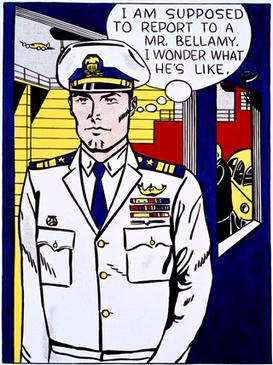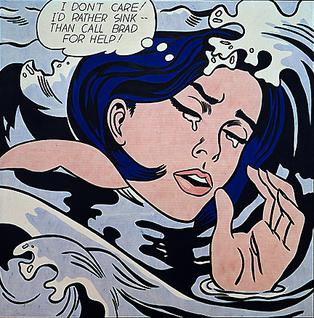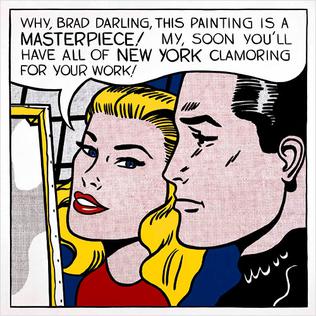
Roy Fox Lichtenstein was an American pop artist. During the 1960s, along with Andy Warhol, Jasper Johns, and James Rosenquist, he became a leading figure in the new art movement. His work defined the premise of pop art through parody. Inspired by the comic strip, Lichtenstein produced precise compositions that documented while they parodied, often in a tongue-in-cheek manner. His work was influenced by popular advertising and the comic book style. His artwork was considered to be "disruptive". He described pop art as "not 'American' painting but actually industrial painting". His paintings were exhibited at the Leo Castelli Gallery in New York City.

Leo Castelli was an Italian-American art dealer who originated the contemporary art gallery system. His gallery showcased contemporary art for five decades. Among the movements which Castelli showed were Surrealism, Abstract Expressionism, Neo-Dada, Pop Art, Op Art, Color field painting, Hard-edge painting, Lyrical Abstraction, Minimal Art, Conceptual Art, and Neo-expressionism.
Ileana Sonnabend was a Romanian-American art dealer of 20th-century art. The Sonnabend Gallery opened in Paris in 1962 and was instrumental in making American art of the 1960s known in Europe, with an emphasis on American pop art. In 1970, Sonnabend Gallery opened in New York on Madison Avenue, and in 1971 relocated to 420 West Broadway in SoHo where it was one of the major protagonists that made SoHo the international art center it remained until the early 1990s. The gallery was instrumental in making European art of the 1970s known in America, with an emphasis on European conceptual art and Arte Povera. It also presented American conceptual and minimal art of the 1970s. In 1986, the so-called "Neo-Geo" show introduced, among others, the artist Jeff Koons. In the late 1990s, the gallery moved to Chelsea and continues to be active after Sonnabend's death. The gallery goes on showing the work of artists who rose to prominence in the 1960s and 1970s including Robert Morris, Bernd and Hilla Becher and Gilbert & George as well as more recent artists including Jeff Koons, Rona Pondick, Candida Höfer, Elger Esser, and Clifford Ross.

Whaam! is a 1963 diptych painting by the American artist Roy Lichtenstein. It is one of the best-known works of pop art, and among Lichtenstein's most important paintings. Whaam! was first exhibited at the Leo Castelli Gallery in New York City in 1963, and purchased by the Tate Gallery, London, in 1966. It has been on permanent display at Tate Modern since 2006.

Mr. Bellamy is a 1961 pop art painting by Roy Lichtenstein in his comic book style of using Ben-Day dots and a text balloon. The work is regarded as one of the better examples of Lichtenstein's sense of humor. The work is held in the collection at the Modern Art Museum of Fort Worth.

Girl with Ball is a 1961 painting by Roy Lichtenstein. It is an oil on canvas Pop art work that is now in the collection of the Museum of Modern Art, after being owned for several decades by Philip Johnson. It is one of Lichtenstein's earliest Pop art works and is known for its source, which is a newspaper ad that ran for several decades and which was among Lichtenstein's earliest works sourced from pop culture.

Torpedo...Los! is a 1963 pop art oil on canvas painting by Roy Lichtenstein. When it was last sold in 1989, The New York Times described the work as "a comic-strip image of sea warfare". It formerly held the record for the highest auction price for a Lichtenstein work. Its 1989 sale helped finance the construction of the current home of the Museum of Contemporary Art, Chicago in 1991.

Look Mickey is a 1961 oil on canvas painting by Roy Lichtenstein. Widely regarded as the bridge between his abstract expressionism and pop art works, it is notable for its ironic humor and aesthetic value as well as being the first example of the artist's employment of Ben-Day dots, speech balloons and comic imagery as a source for a painting. The painting was bequeathed to the Washington, D.C., National Gallery of Art upon Lichtenstein's death.

Drowning Girl is a 1963 American painting in oil and synthetic polymer paint on canvas by Roy Lichtenstein, based on original art by Tony Abruzzo. The painting is considered among Lichtenstein's most significant works, perhaps on a par with his acclaimed 1963 diptych Whaam!. One of the most representative paintings of the pop art movement, Drowning Girl was acquired by the Museum of Modern Art in 1971.

Roto Broil is a 1961 pop art painting by Roy Lichtenstein. It was one of the consumer goods paintings made in the early 1960s that "made a splash, sold well and immediately polarized the critics."

Blam is a 1962 painting by Roy Lichtenstein falling within the pop art idiom. It is one of his military comic book derivatives and was one of the works presented at his first solo exhibition. The work is in the collection at the Yale University Art Gallery

Engagement Ring is a 1961 pop art painting by Roy Lichtenstein. The work is based on the Winnie Winkle series, but Lichtenstein changed both the graphical description and the narrative accompaniment that he presents in a speech balloon. As with most of his early romance comics works, this consisted of "a boy and a girl connected by romantic dialogue and action".

Golf Ball is a 1962 painting by Roy Lichtenstein. It is considered to fall within the art movement known as pop art. It depicts "a single sphere with patterned, variously directional semi-circular grooves." The work is commonly associated with black-and-white Piet Mondrian works. It is one of the works that was presented at Lichtenstein's first solo exhibition and one that was critical to his early association with pop art. The work is commonly critiqued for its tension involving a three-dimensional representation in two dimensions with much discussion revolving around the choice of a background nearly without any perspective.

In the Car is a 1963 pop art painting by Roy Lichtenstein. The smaller, older of the two versions of this painting formerly held the record for highest auction price for a Lichtenstein painting. The larger version has been in the collection of the Scottish National Gallery of Modern Art in Edinburgh since 1980.

Happy Tears is a 1964 pop art painting by Roy Lichtenstein. It formerly held the record for highest auction price for a Lichtenstein painting.

Woman with Flowered Hat is a 1963 pop art painting with Magna on canvas by Roy Lichtenstein. The work is based on a Pablo Picasso portrait of Dora Maar. In May 2013, it sold for a record price for a Lichtenstein work.

Crying Girl is the name of two different works by Roy Lichtenstein: a 1963 offset lithograph on lightweight, off-white wove paper and a 1964 porcelain enamel on steel.

Masterpiece is a 1962 pop art painting by Roy Lichtenstein that uses his classic Ben-Day dots and narrative content contained within a speech balloon. In 2017, the painting sold for $165 million.
We Rose Up Slowly is a 1964 painting by Roy Lichtenstein. Materials includes oil and magna on two canvas panels. The painting measures 68 inches (170 cm) x 92 inches (230 cm). It was exhibited at the Art Institute of Chicago. and Centre Pompidou. It is in the collection of the Museum für Moderne Kunst.

Crak! is a 1963 pop art lithograph by Roy Lichtenstein in his comic book style of using Ben-Day dots and a text balloon. It was used in marketing materials for one of Lichtenstein's early shows. It is one of several of his works related to military art and monocular vision.


















